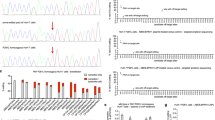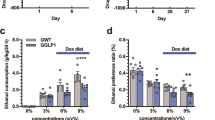Abstract
Phenylketonuria, PKU, is caused by deficiency of phenylalanine hydroxylase (PAH) resulting in increased levels of phenylalanine in body fluids. PAH requires the non-protein cofactor BH4 and the rate-limiting step in the synthesis of BH4 is GTP cyclohydrolase I (GTP-CH). Here we show that overexpression of the two enzymes PAH and GTP-CH in primary human keratinocytes leads to high levels of phenylalanine clearance without BH4 supplementation. Integration of multiple PAH and GTP-CH transgenes were achieved after optimized retroviral transduction. Phenylalanine clearance was measured ex vivo in primary human keratinocytes cotransduced with PAH and GTP-CH (more than 370 nmol/24 h/106 cells), a level exceeding that of a human liver cell line (HepG2 cells). Cells overexpressing either one of the enzymes alone did not clear significant amounts of phenylalanine. Transfer of the two genes into the same cell was not necessary, since cocultivation of cells transduced separately with PAH and GTP-CH also resulted in phenylalanine clearance. Thus the experiments indicate metabolic cooperation between cells overexpressing PAH and cells overexpressing GTP-CH, possibly due to intercellular transport of synthesized BH4.
This is a preview of subscription content, access via your institution
Access options
Subscribe to this journal
Receive 12 print issues and online access
$259.00 per year
only $21.58 per issue
Buy this article
- Purchase on Springer Link
- Instant access to full article PDF
Prices may be subject to local taxes which are calculated during checkout





Similar content being viewed by others
References
Kaufman S . Phenylketonuria: biochemical mechanisms Adv Neurochem 1977 2: 1–132
Hufton SE, Jennings IG, Cotton RG . Structure and function of the aromatic amino acid hydroxylases Biochem J 1995 311: 353–366
Thony B, Auerbach G, Blau N . Tetrahydrobiopterin biosynthesis, regeneration and functions Biochem J 2000 347: 1–16
Greeves LG et al. Effect of genotype on changes in intelligence quotient after dietary relaxation in phenylketonuria and hyperphenylalaninaemia Arch Dis Child 2000 82: 216–221
Moats RA et al. Brain phenylalanine concentration in the management of adults with phenylketonuria J Inherit Metab Dis 2000 23: 7–14
Fitzgerald B et al. An investigation into diet treatment for adults with previously untreated phenylketonuria and severe intellectual disability J Intellect Disabil Res 2000 44: 53–59
Lenke RR, Levy HL . Maternal phenylketonuria and hyperphenylalaninemia. An international survey of the outcome of untreated and treated pregnancies New Engl J Med 1980 303: 1202–1208
Fang B et al. Gene therapy for phenylketonuria: phenotypic correction in a genetically deficient mouse model by adenovirus-mediated hepatic gene transfer Gene Therapy 1994 1: 247–254
Eisensmith RC, Woo SL . Gene therapy for phenylketonuria Acta Paediatr Suppl 1994 407: 124–129
Nagasaki Y et al. Reversal of hypopigmentation in phenylketonuria mice by adenovirus-mediated gene transfer Pediatr Res 1999 45: 465–473
Lin CM et al. Expression of human phenylalanine hydroxylase activity in T lymphocytes of classical phenylketonuria children by retroviral-mediated gene transfer J Inherit Metab Dis 1997 20: 742–754
Harding CO et al. Metabolic engineering as therapy for inborn errors of metabolism – development of mice with phenylalanine hydroxylase expression in muscle Gene Therapy 1998 5: 677–683
Katz AB, Taichman LB . A partial catalog of proteins secreted by epidermal keratinocytes in culture J Invest Dermatol 1999 112: 818–821
Kolodka TM, Garlick JA, Taichman LB . Evidence for keratinocyte stem cells in vitro: long term engraftment and persistence of transgene expression from retrovirus-transduced keratinocytes Proc Natl Acad Sci USA 1998 95: 4356–4361
Mathor MB et al. Clonal analysis of stably transduced human epidermal stem cells in culture Proc Natl Acad Sci USA 1996 93: 10371–10376
Barra RM, Fenjves ES, Taichman LB . Secretion of apolipoprotein E by basal cells in cultures of epidermal keratinocytes J Invest Dermatol 1994 102: 61–66
Gerrard AJ et al. Towards gene therapy for haemophilia B using primary human keratinocytes Nat Genet 1993 3: 180–183
Jensen UB et al. Gene transfer into cultured human epidermis and its transplantation on to immunodeficient mice: an experimental model for somatic gene therapy J Invest Dermatol 1994 103: 391–394
Fenjves ES et al. Keratinocyte gene therapy for adenosine deaminase deficiency: a model approach for inherited metabolic disorders Hum Gene Ther 1997 8: 911–917
Sullivan DM et al. Ornithine-delta-aminotransferase expression and ornithine metabolism in cultured epidermal keratinocytes: toward metabolic sink therapy for gyrate atrophy Gene Therapy 1997 4: 1036–1044
Schallreuter KU et al. Regulation of melanin biosynthesis in the human epidermis by tetrahydrobiopterin Science 1994 263: 1444–1446
Schallreuter KU et al. In vivo evidence for compromised phenylalanine metabolism in vitiligo Biochem Biophys Res Commun 1998 243: 395–399
Wildner O et al. Generation of a conditionally neo(r)-containing retroviral producer cell line: effects of neo(r) on retroviral titer and transgene expression Gene Therapy 1998 5: 684–691
Ledley FD, Grenett HE, Woo SL . Biochemical characterization of recombinant human phenylalanine hydroxylase produced in Escherichia coli J Biol Chem 1987 262: 2228–2233
Ghazizadeh S, Harrington R, Taichman L . In vivo transduction of mouse epidermis with recombinant retroviral vectors: implications for cutaneous gene therapy Gene Therapy 1999 6: 1267–1275
Waters PJ et al. Missense mutations in the phenylalanine hydroxylase gene (PAH) can cause accelerated proteolytic turnover of PAH enzyme: a mechanism underlying phenylketonuria J Inherit Metab Dis 1999 22: 208–212
Laufs S, Blau N, Thony B . Retrovirus-mediated double transduction of the GTPCH and PTPS genes allows 6-pyruvoyltetrahydropterin synthase-deficient human fibroblasts to synthesize and release tetrahydrobiopterin J Neurochem 1998 71: 33–40
Bencsics C et al. Double transduction with GTP cyclohydrolase I and tyrosine hydroxylase is necessary for spontaneous synthesis of L-DOPA by primary fibroblasts J Neurosci 1996 16: 4449–4456
Leff SE et al. In vivo L-DOPA production by genetically modified primary rat fibroblast or 9L gliosarcoma cell grafts via coexpression of GTPcyclohydrolase I with tyrosine hydroxylase Exp Neurol 1998 151: 249–264
Weinstein GD, McCullough JL, Ross P . Cell proliferation in normal epidermis J Invest Dermatol 1984 82: 623–628
Scriver CR, Kaufman S, Eisensmith RC, Woo SLC . The hyperphenylalaninemias. In: The Metabolic and Molecular Bases of Inherited Disease McGraw-Hill: New York 1995 pp 1015–1075
Suzuki T et al. Characterization of wild-type and mutants of recombinant human GTP cyclohydrolase I: relationship to etiology of dopa-responsive dystonia J Neurochem 1999 73: 2510–2416
Waters PJ et al. In vitro expression analysis of mutations in phenylalanine hydroxylase: linking genotype to phenotype and structure to function Hum Mutat 1998 11: 4–17
Onodera M et al. A simple and reliable method for screening retroviral producer clones without selectable markers Hum Gene Ther 1997 8: 1189–1194
Havenga M et al. Improved screening method for recombinant retrovirus producing clones Biotechniques 1996 21: 1004–1007
Jensen TG et al. Retrovirus-mediated gene transfer of ornithine-delta-aminotransferase into keratinocytes from gyrate atrophy patients Hum Gene Ther 1997 8: 2125–2132
Rheinwald JG, Green H . Serial cultivation of strains of human epidermal keratinocytes: the formation of keratinizing colonies from single cells Cell 1975 6: 331–343
Wu YJ et al. The mesothelial keratins: a new family of cytoskeletal proteins identified in cultured mesothelial cells and nonkeratinizing epithelia Cell 1982 31: 693–703
Chuah MK, Vandendriessche T, Morgan RA . Development and analysis of retroviral vectors expressing human factor VIII as a potential gene therapy for hemophilia A Hum Gene Ther 1995 6: 1363–1377
Markowitz D, Goff S, Bank A . A safe packaging line for gene transfer: separating viral genes on two different plasmids J Virol 1988 62: 1120–1124
Garlick JA et al. Retrovirus-mediated transduction of cultured epidermal keratinocytes J Invest Dermatol 1991 97: 824–829
McCaman M, Robins, E . Fluorimetric method for the determination of phenylalanine in serum J Lab Clin Med 1962 59: 885–890
Sambrook J, Fritsch EF, Maniatis T . Molecular Cloning: A Laboratory Manual Cold Spring Harbor Laboratory Press: Cold Spring Harbor, NY 1989
Acknowledgements
Anne Keblovszki and Bodil Schmidt are thanked for excellent technical assistance. This work was supported by The Danish Medical Research Council, Novo Nordisk Fonden, Aarhus Universitets Forskningsfond, Karen Elise Jensen Fonden and Laegeforeningens Forskningsfond.
Author information
Authors and Affiliations
Rights and permissions
About this article
Cite this article
Christensen, R., Kolvraa, S., Blaese, R. et al. Development of a skin-based metabolic sink for phenylalanine by overexpression of phenylalanine hydroxylase and GTP cyclohydrolase in primary human keratinocytes. Gene Ther 7, 1971–1978 (2000). https://doi.org/10.1038/sj.gt.3301337
Received:
Accepted:
Published:
Issue Date:
DOI: https://doi.org/10.1038/sj.gt.3301337
Keywords
This article is cited by
-
Engineering and Kinetic Stabilization of the Therapeutic Enzyme Anabeana variabilis Phenylalanine Ammonia Lyase
Applied Biochemistry and Biotechnology (2013)
-
Correction of Murine PKU Following AAV-mediated Intramuscular Expression of a Complete Phenylalanine Hydroxylating System
Molecular Therapy (2008)
-
Long-term correction of hyperphenylalaninemia by AAV-mediated gene transfer leads to behavioral recovery in phenylketonuria mice
Gene Therapy (2004)
-
‘Mommy, why can't I have a hamburger like the other kids?’
Gene Therapy (2000)



